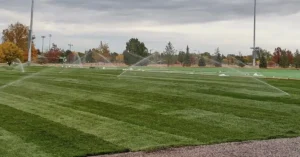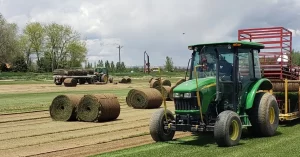
Time to start caring for your lawn to get it strong and healthy for the summer months. Having a great lawn begins in the spring! Here are some Spring Lawn Care Cleanup Basics:
 Overall Clean-up: Mid-March is time to get those fallen leaves, branches and neighborhood trash up from the yard and flower beds. Power blowers work best, but if you don’t have a blower use a rake to get to the debris. Be sure to go lightly on the raking! If your lawn is s all wet, wait to rake un l it’s dry. Use a springy, light rake to “fluff up” the lawn, separate ng grass shoots and increasing air circulation on. Now is a great me to get a good overview of the state of your lawn– dead spots, maed patches, thatch or compacted soil. DON’T do a power raking or area on your lawn- YET. It’s advised that you avoid the practice of aggressively raking un l the lawn if quite firm, usually in late April or even May. This will reduce the amount of damage to tender grass plants as they are breaking dormancy.. Also, be sure to clean up the dog poo while you’re out there– your lawn will thank you.
Overall Clean-up: Mid-March is time to get those fallen leaves, branches and neighborhood trash up from the yard and flower beds. Power blowers work best, but if you don’t have a blower use a rake to get to the debris. Be sure to go lightly on the raking! If your lawn is s all wet, wait to rake un l it’s dry. Use a springy, light rake to “fluff up” the lawn, separate ng grass shoots and increasing air circulation on. Now is a great me to get a good overview of the state of your lawn– dead spots, maed patches, thatch or compacted soil. DON’T do a power raking or area on your lawn- YET. It’s advised that you avoid the practice of aggressively raking un l the lawn if quite firm, usually in late April or even May. This will reduce the amount of damage to tender grass plants as they are breaking dormancy.. Also, be sure to clean up the dog poo while you’re out there– your lawn will thank you.
Test your Soil’s PH : There is no better way to save money on water and soil amendments than going a handle on what your lawn actually needs. Do-it-yourself soil test kits are a great way to learn about soil health, and can be purchased at a home improvement store or your local nursery. You can also purchase testing meters that measure pH, moisture and light. A soil test determines whether your soil is acidic, neutral or alkaline, and indicate which elements are missing and how much to add to remedy the problem. Since soil is made up of minerals, organic matter (living and dead), healthy soil provides nutrients and serves as a foundation for healthy plants. Improve your soil and plant health and enjoy a beautiful lawn or garden for a lifetime.
CSU Lawncheck: CSU provides an inexpensive, on-site lawn consult on service conducted by CSU hor cultural specialists who will come to your home and make recommendations for improving your lawn and solving insect, disease and other lawn problems. For more information: http://lawncheck.colostate.edu
 CSU Lawncheck is currently available from Colorado State University Extension offices in the following counties:
CSU Lawncheck is currently available from Colorado State University Extension offices in the following counties:
● Adams – (303)-637-8100
● Arapahoe – (303) 730-1920
● Boulder – (303) 678-6238
● Denver/Jefferson – (303) 271-6620
● Larimer – (970) 498-6000
CSU Extension office: A great resource, by phone or email If you have lawn questions, and there’s no charge. Your message should include a short, detailed description of the problem and its location on in the landscape.
 Overseeding: Got bare patches or winter kill? Early spring is time to lay down seed to patch these areas. You can use plain seed or a repair mix that incorporates mulch. The first step is to rake out some of the dead in the area. You don’t have to remove it completely. “Fan” a very thin layer of soil/compost mix over the area. Next, spread the seed lightly without overcrowding. Finally, lightly drag the seed into the soil with the back of your hand or the back of a rake. This will ensure that the seed is in full contact with the ground, but not buried.
Overseeding: Got bare patches or winter kill? Early spring is time to lay down seed to patch these areas. You can use plain seed or a repair mix that incorporates mulch. The first step is to rake out some of the dead in the area. You don’t have to remove it completely. “Fan” a very thin layer of soil/compost mix over the area. Next, spread the seed lightly without overcrowding. Finally, lightly drag the seed into the soil with the back of your hand or the back of a rake. This will ensure that the seed is in full contact with the ground, but not buried.
If you seed in late March, don’t water the new seed. The spring weather
will probably take care of getting the seed off to a good start. In later April or May, you will need to water at once and keep the seedbed moist for 30 days while the seed grows.
 Apply Fertilizer: Many homeowners apply way too much fertilizer at the first sign of green grass growth. In reality, the best thing to do is to apply a light amount of fertilizer in early spring, and then apply a larger dose a bit later in the season, after the inial growth rush. It may seem early to start fertilizing but if you’re looking for the “Best Yard on the Block” award, fertilizing now is going to help your lawn wake up quicker and stronger.
Apply Fertilizer: Many homeowners apply way too much fertilizer at the first sign of green grass growth. In reality, the best thing to do is to apply a light amount of fertilizer in early spring, and then apply a larger dose a bit later in the season, after the inial growth rush. It may seem early to start fertilizing but if you’re looking for the “Best Yard on the Block” award, fertilizing now is going to help your lawn wake up quicker and stronger.
CSU – Homeowner’s Guide to Fertilizing your Lawn & Garden
Apply Pre-Emergent Herbicide: It’s often easier to fight weeds before they even emerge, rather than wai ng un l they rear their ugly heads. Mid-March is the best me to control crabgrass and other weeds because they will not be growing yet, but will begin very soon. The herbicide is less effec ve once weeds have significantly grown and developed. At that point, good ol’ fashion weed plucking may be your best op on.
 Prepare your Mower: Would you allow a hairstylist to cut your hair with a pair of dull scissors? It’s me to tune-up your lawn mower and sharpen or replace your lawn mower blades. Dull blades tear the grass leaf instead of cutting it smoothly. Tearing weakens the grass plant and can promote disease and insects. Be sure to clean maed grass from the underside of the mower. Is it me for a new spark plug? Engine Oil? Fuel Filter? If you need assistance, consult an expert in your area.
Prepare your Mower: Would you allow a hairstylist to cut your hair with a pair of dull scissors? It’s me to tune-up your lawn mower and sharpen or replace your lawn mower blades. Dull blades tear the grass leaf instead of cutting it smoothly. Tearing weakens the grass plant and can promote disease and insects. Be sure to clean maed grass from the underside of the mower. Is it me for a new spark plug? Engine Oil? Fuel Filter? If you need assistance, consult an expert in your area.
Different grass types have different op mum mowing lengths. For Bluegrass and Fescue, a height of about 2 to 2.5 inches for the first few spring mowings is good. After that, you should raise the mowing deck to a height of about 3 inches. It’s never healthy for your lawn if you cut more than 1/3 of the grass height at a time, and be sure to sharpen those blades again in late July or early August if you have an average lot size. One last p–change your mowing pattern each me you mow. This will prevent wearing of track marks on your lawn.
Aeration: In late April, revisit your soil health by aerating. Aerating on involves perforating the soil with small holes to allow air, water, and nutrients to penetrate the grassroots. This helps the roots grow deeper and produce a stronger, more vigorous lawn. The main reason for aerating is to alleviate soil compaction.
Dethatching : Healthy grass has some thatch. Korby Sod does not recommend dethatching unless you know for a fact you have an excessive thatch issue. A thatch layer less than 1/2ʺ thick is not a problem. If the thatch layer gets thick enough that water and air have trouble going to grassroots, that is excessive. To measure the thickness of thatch, poke through the grass un l you find the brown layer near the bottom of the grass blade. With your finger or a stick, poke a hole through the brown layer to the top of the soil. Measure the thickness of the thatch. A vigorous raking or power raking should only be done in late April or early May.





